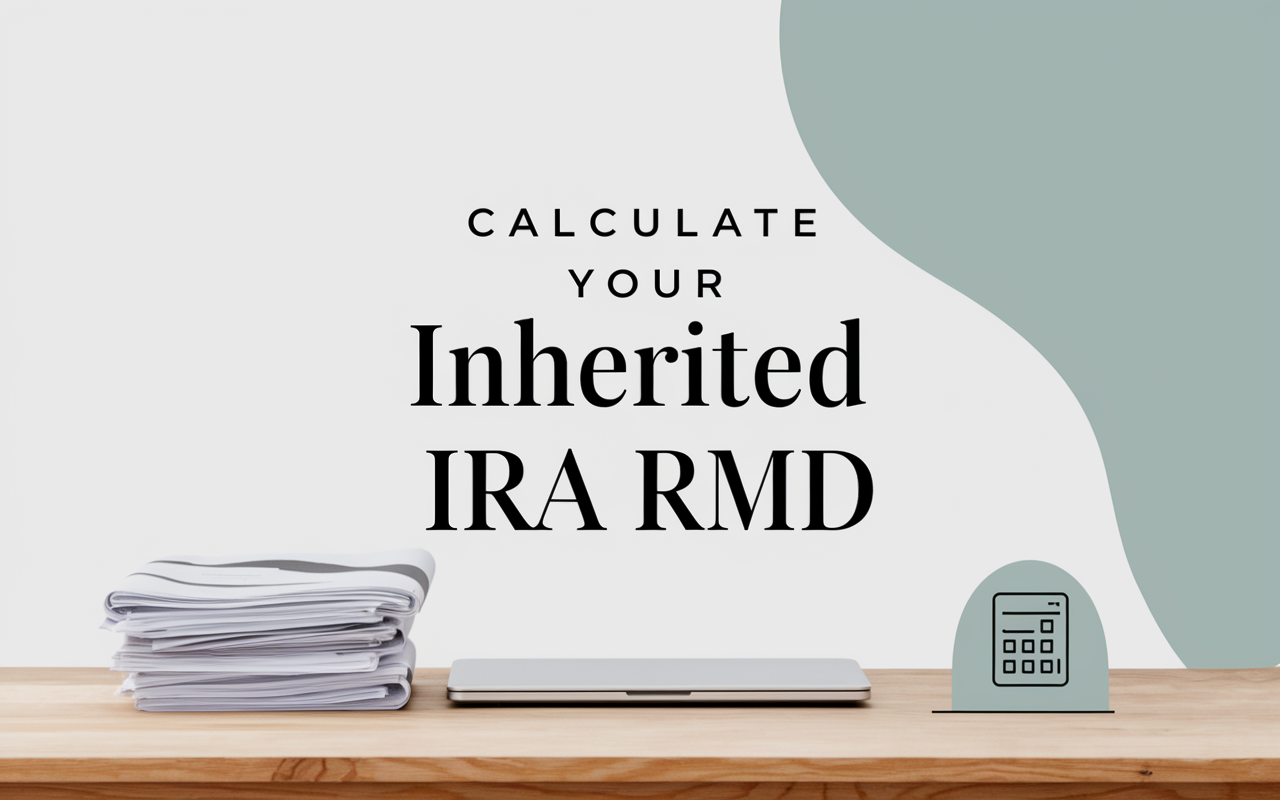Calculate Your Inherited IRA RMD Under 2025 Rules: A Comprehensive Guide
For federal employees and military service members who have spent decades serving our nation, retirement can bring immense relief, excitement, and—unfortunately—some confusion. One area that often causes concern is managing inherited IRAs. If you have recently inherited an IRA or anticipate inheriting one, understanding the RMD for inherited IRA accounts under the new 2025 rules is essential. If you miss key deadlines, the potential penalties can be substantial, and the missed financial opportunities can be even larger. Fortunately, with proper guidance and careful planning, you can navigate these rules confidently and avoid costly missteps.
Before diving into the details, let’s clarify what an inherited IRA actually is. When an IRA account owner passes away, the money in that IRA can be passed on to a beneficiary. Depending on whether you inherit from a spouse, non-spouse, or a more complex arrangement such as a trust, distribution requirements can vary substantially. Recent changes introduced by the SECURE Act of 2019 and SECURE Act 2.0 of 2022 have tightened the rules on just how long those inherited IRA balances can stay untouched—with full implementation of new provisions set to take effect in 2025. Federal employees nearing retirement often juggle their Thrift Savings Plan (TSP), potential military pensions, and Social Security. Adding an inherited IRA’s Required Minimum Distribution (RMD) schedule on top can feel overwhelming.
If questions like “Do I have to withdraw funds every year?” or “What if I inherit a Roth IRA?” have crossed your mind, you’re not alone. Let’s walk through these uncertainties so you can move forward with confidence.
Understanding the New 2025 RMD Rules for Inherited IRAs
The upcoming 2025 rules impact both spouse and non-spouse beneficiaries, although the changes feel more pronounced for non-spouse beneficiaries. Generally, non-spouse beneficiaries must adhere to a “10-year rule,” meaning the entire balance of the inherited IRA needs to be distributed by the end of the 10th year following the account owner’s death. Prior to the SECURE Act, many beneficiaries could take distributions over their own lifetime—a strategy often called the “stretch IRA.” Today, that strategy is restricted mostly to eligible designated beneficiaries such as spouses, minor children, and individuals with special health circumstances. If you’re curious whether you fall into that category, it’s important to review the official definitions or speak with a financial advisor for federal employees.
Keep in mind the RMD start age for traditional IRAs is shifting as well. It’s currently 73 in 2023, but it’s set to move to 75 in 2033. This remains relevant to some inherited IRA situations, particularly for spouse beneficiaries who might choose to treat an inherited IRA as their own.
One area that’s created confusion is when the original IRA owner was already taking RMDs at the time of death. Under certain scenarios, annual RMDs may still be required during the 10-year window, rather than simply emptying the account at will. It’s a sticking point that has caught more than a few people off-guard. If you’re 70, for instance, and inherit a non-spousal IRA from someone who was already into their own RMD schedule, be sure to double-check if you need to take a smaller distribution each year, or if you have more flexibility.
The Calculation Process for an Inherited IRA RMD
Calculating your inherited IRA RMD starts with knowing your inherited account’s December 31 balance of the previous year. Then you identify your beneficiary category—spouse or non-spouse—and find the corresponding factor on the correct life expectancy table (such as the Single Life Expectancy Table for most non-spouse beneficiaries). The general calculation looks like this:
RMD = (Previous year-end balance) / (Life expectancy factor)
For example, if you have a $200,000 inherited IRA, and the life expectancy factor for a 55-year-old beneficiary is 31.6, then you would calculate:
$200,000 ÷ 31.6 ≈ $6,329.11
This annual figure changes year to year as you get older and the balance fluctuates. If you have multiple inherited IRAs, each one will require separate calculations, though you can often choose to withdraw the total from one or more of your inherited IRAs—as long as they are the same type (e.g., inherited traditional IRAs).
Spouse vs. Non-Spouse Beneficiaries: Key Differences
Being a spouse beneficiary has considerable advantages. You can generally do one of three things: treat the IRA as your own (rolling it over to your existing IRA), defer RMDs until your deceased spouse would have turned 73 (or 75 in the future), or withdraw annually based on your own life expectancy. By contrast, RMD inherited IRA rules for non-spouse beneficiaries are typically stricter, often mandating the 10-year distribution window. If the original owner had begun taking RMDs, you might have to take annual RMDs each year until the account is depleted.
Non-compliance can be expensive. If you miss any RMD or fail to take the full amount, you could face a 25% penalty on the undistributed funds (though this can drop to 10% if you correct the oversight promptly). For non-spouse beneficiaries, the question “Should I roll an inherited IRA into my own?” isn’t even an option. Only spouses can make that move. Your best course of action lies in understanding the precise inheritance rules and deadlines you’re subject to and taking timely distributions to avoid penalties.
Focus on Inherited Roth IRAs
Even though a Roth IRA grows tax-free, inherited Roth IRA distribution rules still require distributions for non-spouse beneficiaries. It surprises many to learn that an inherited Roth IRA typically must be emptied within 10 years for non-eligible beneficiaries, even if no regular RMDs are required each individual year in certain situations. On the upside, because the account is Roth, those distributions are usually tax-free (assuming the original account satisfied the five-year holding rule). For spouse beneficiaries, the typical Roth IRA RMD rules are even more relaxed, allowing you to treat the inherited Roth IRA as your own. That can mean no lifetime RMDs, just as if it originated under your name.
Questions such as “Can I hold onto an inherited Roth IRA forever?” are natural. Most non-spouse beneficiaries must empty the account by the 10th year, but you won’t necessarily owe taxes on the distributions. The difference between spouse and non-spouse rules here is significant, so it’s well worth clarifying which category applies to you.
QCD from Inherited IRAs
Another noteworthy option is making a Qualified Charitable Distribution (QCD) from your inherited IRA. A Qualified Charitable Distribution allows you to transfer funds directly from your inherited IRA to a qualified charity, effectively reducing your taxable income. While a QCD can satisfy your RMD for that year up to the QCD amount, there are eligibility rules to consider, such as age limits and the type of inherited IRA involved. If charitable giving is part of your retirement or estate plan, a QCD can be a strategic move to support causes you care about while also mitigating some tax impact. This can be particularly beneficial for federal employees who foresee higher taxable income in certain years due to accrued leave payouts or other benefits.
Key Differences for Beneficiary Types and Distribution Rules
Here is a snapshot of how the 2025 rules generally differentiate among beneficiaries:
|
Beneficiary Type |
Distribution Rule |
Key Deadline |
Penalty Considerations |
|---|---|---|---|
|
Spouse |
May treat IRA as own or use inherited IRA |
RMDs can start when deceased spouse would have reached RMD age |
25% penalty for missed RMD |
|
Non-Spouse |
10-year rule (entire balance in 10 years) |
December 31 of 10th year after death |
25% penalty for missed distributions |
|
Eligible Designated |
Based on own life expectancy |
Generally annual RMDs start the year after death |
Varies if minor child transitions to 10-year rule at majority |
This table can help you quickly identify which category you fall into and plan accordingly. If you discover that you belong in the “eligible designated” group—like a minor child or a disabled beneficiary—longer-term, annual RMDs might still be possible. Everyone else will need to operate under the 10-year rule, being mindful of any annual distribution requirements along the way.
Life Expectancy Factors (Single Life Expectancy Table)*
The single life expectancy table is critical for calculating your inherited IRA’s RMD if you qualify to spread distributions out rather than emptying the account within 10 years. Below is a brief example of what a life expectancy table might look like for certain ages:
|
Age |
Life Expectancy Factor |
|---|---|
|
55 |
31.6 |
|
56 |
30.6 |
|
57 |
29.7 |
(*Excerpted from IRS Publication 590-B for illustration)
As you can see, the factor decreases with age. Using this table, you’d divide your inherited IRA balance by the appropriate factor to calculate the annual RMD. Over time, these factors shift, so it’s important to update your calculation each year. If you need support figuring out whether you qualify for life-expectancy-based RMDs, or whether the 10-year rule applies, it’s wise to sit down with a qualified advisor who can interpret your specific situation.
Planning Tips and Strategies
For federal employees who also manage a TSP, taking RMDs from an inherited IRA can add another layer to your retirement income puzzle. Here are some considerations to keep in mind:
If you’re approaching a high-income year, you might opt to delay some of your IRA distributions (if you have that flexibility under the rules) to smooth out your tax bill. On the other hand, taking smaller, regular RMDs each year can prevent you from facing a more significant tax hit in the 10th year. It’s also worth noting that your TSP distributions and pension income can push you into a higher bracket, so coordinating withdrawal timing between your TSP, pension, and inherited IRA is crucial.
For those who are charitably inclined, designing a QCD strategy from your inherited IRA could be the perfect mix of philanthropic giving and tax efficiency. Remember to confirm that you meet age requirements and distribute the funds correctly so that the QCD counts toward satisfying your RMD for the year. It’s a great tool for reducing your taxable income without losing the benefits of a philanthropic donation.
Next Steps: Seeking Professional Guidance
Due to rapidly evolving legislation and the individualized nature of personal finances, there is no one-size-fits-all solution. If you’re a federal employee with a soon-to-be-inherited IRA, or you’re already the beneficiary of one, professional advice can help ensure you don’t leave any money on the table—or risk penalties by missing an RMD. At PlanWell, our advisors hold the Chartered Federal Employee Benefits Consultant (ChFEBC), CERTIFIED FINANCIAL PLANNER™ (CFP®), and Accredited Investment Fiduciary (AIF®) designations—giving us specialized expertise to guide you through these rules as they relate to your federal benefits.
Tools like IRS Publication 590-B and online RMD calculators can provide a baseline understanding. But more advanced strategies, including disclaimers, spousal rollovers, or naming a trust as beneficiary, can bring additional complexities. This is where in-depth expertise can make a major difference—especially for federal employees who must also consider government pensions, FEHB, FEGLI, and other unique benefits.
If you’re wondering how all these pieces fit together into a broader retirement strategy, we invite you to sign up for one of our free Federal Retirement Planning Workshops. With the right plan in place, you’ll tap into the full power of your federal benefits while ensuring that your inherited IRA is optimally managed for you and your loved ones.
Conclusion
Staying on top of your inherited IRA RMD rules in 2025 isn’t just about avoiding costly penalties—it’s about actively protecting the financial legacy passed down to you or your family. Properly timing your withdrawals can preserve more of the investment’s growth potential, and taking advantage of tools like QCDs can reduce your tax burden. Meanwhile, spouse beneficiaries often benefit from special flexibility that can dramatically change their retirement outlook, especially if they’re synchronizing strategies with their TSP or other retirement accounts.
In other words, knowledge is your best defense—and your best asset. By learning the difference between spouse and non-spouse rules, understanding inherited Roth IRA distribution rules, and making use of the life expectancy tables where you qualify, you can bring clarity to what can otherwise feel like a maze of regulations. The ultimate takeaway: with a well-considered plan, your inherited IRA distributions can become a key contributor to a secure retirement—rather than a source of stress and uncertainty.










